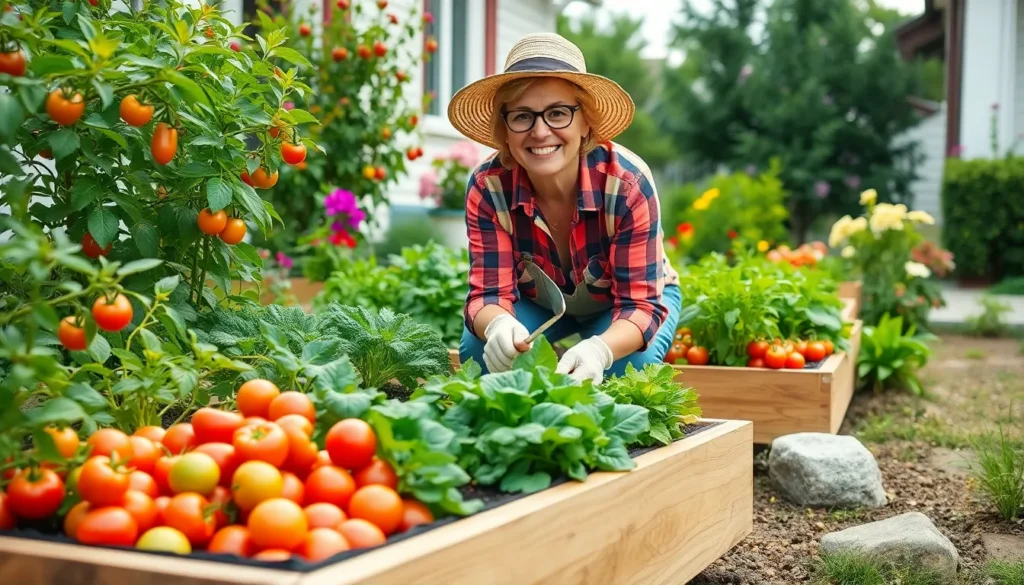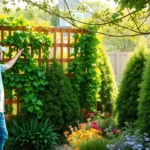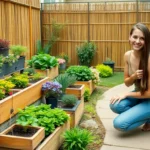Transforming your front yard into a productive vegetable garden isn’t just possible—it’s becoming the hottest trend in home gardening. We’re seeing more homeowners ditch traditional lawns for edible landscapes that feed families while boosting curb appeal.
Gone are the days when vegetable gardens belonged only in backyards. Today’s front yard food gardens combine beauty with function creating stunning displays that’ll make your neighbors stop and stare. From raised bed masterpieces to creative container arrangements we’ve discovered countless ways to turn your front space into an abundant harvest zone.
The best part? You don’t need extensive gardening experience or a massive budget to get started. We’ll show you how strategic planning and smart design choices can transform even the smallest front yard into a thriving vegetable paradise that produces fresh food year-round while increasing your home’s value.
Transform Your Front Lawn Into a Productive Vegetable Paradise
Converting your traditional front lawn into a thriving vegetable garden requires strategic planning and thoughtful execution. We’ll guide you through the essential steps to create a productive edible industry that enhances your property’s appeal.
Choose the Right Location for Maximum Sun Exposure
Assess your front yard’s sunlight patterns throughout the day. Most vegetables need 6-8 hours of direct sunlight to produce optimal yields. We recommend observing your yard from morning until evening to identify the brightest spots.
Position heat-loving crops like tomatoes, peppers, and squash in areas receiving full sun exposure. These vegetables thrive in locations that get uninterrupted sunlight from 10 AM to 4 PM. Southern-facing areas typically provide the most consistent light throughout growing seasons.
Place shade-tolerant vegetables such as lettuce, spinach, and kale in partially shaded zones. These leafy greens actually benefit from afternoon shade during hot summer months. Areas near trees, fences, or structures can work perfectly for these crops.
Document sun patterns during different seasons to maximize year-round productivity. Winter sun angles differ significantly from summer positions, affecting which areas receive adequate light. Taking photos at various times helps you plan seasonal rotations effectively.
Test and Prepare Your Soil for Optimal Growth
Test your soil’s pH level using a digital meter or testing kit from your local garden center. Most vegetables prefer slightly acidic to neutral soil between 6.0 and 7.0 pH. We suggest testing multiple areas since soil conditions can vary across your front yard.
Amend clay or sandy soils with organic compost to improve drainage and nutrient retention. Adding 2-3 inches of quality compost annually transforms poor soil into fertile growing medium. Mushroom compost, aged manure, and leaf mold work exceptionally well for soil improvement.
Remove existing grass and weeds before establishing your vegetable beds. Smothering methods using cardboard or industry fabric eliminate grass without harmful chemicals. This process typically takes 6-8 weeks but creates clean planting areas.
Install proper drainage systems in areas prone to water accumulation. French drains or raised beds prevent root rot in vegetables sensitive to waterlogged conditions. Adequate drainage becomes especially important during heavy rain seasons.
Plan Your Layout for Both Beauty and Function
Design pathways using attractive materials like flagstone, brick, or decorative gravel between planting areas. These walkways provide easy access for maintenance while creating visual structure. We recommend 2-3 foot wide paths for comfortable navigation with garden tools.
Arrange vegetables by height to create visual depth and prevent taller plants from shading shorter ones. Place climbing beans, corn, and trellised tomatoes toward the back of beds. Position low-growing herbs, lettuce, and root vegetables in front sections.
Incorporate decorative elements such as garden sculptures, colorful planters, or attractive trellises. These features maintain curb appeal while supporting functional growing systems. Copper trellises and cedar raised beds add both beauty and longevity to your design.
Group plants with similar watering needs together to simplify irrigation management. Mediterranean herbs like rosemary and thyme require less water than leafy vegetables. Creating hydro-zones reduces water waste and prevents over or under-watering sensitive plants.
Create Raised Bed Gardens for Easy Maintenance and Curb Appeal
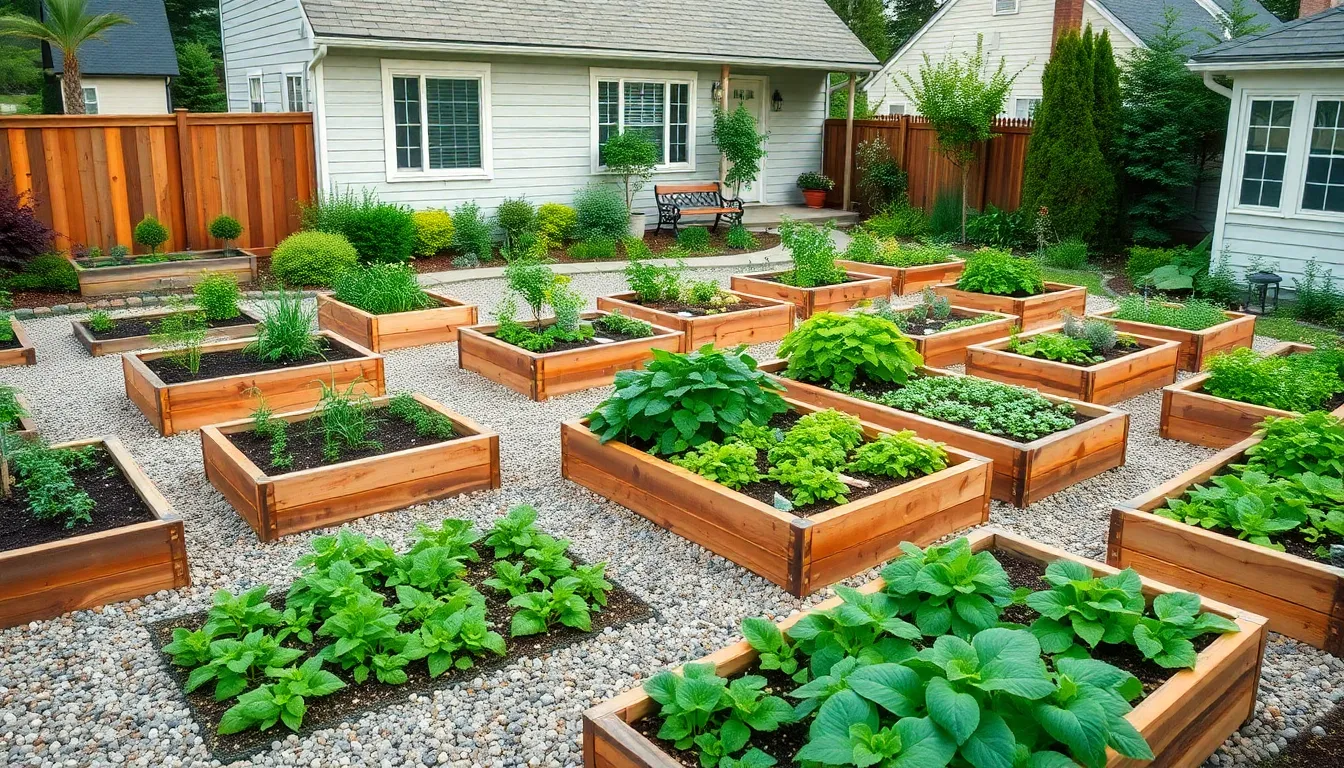
Raised beds transform your front yard vegetable garden into an organized, attractive focal point that’s easier to maintain than traditional ground-level plantings. We’ll explore how these structured growing spaces combine functionality with visual appeal to create stunning edible landscapes.
Design Geometric Patterns for Visual Interest
Square and rectangular bed arrangements create striking symmetrical patterns that make your vegetable garden a true design feature. Parterre-style layouts using geometric shapes add formal elegance while maintaining the practical benefits of organized growing spaces. We recommend positioning beds in repeating patterns that draw the eye through your garden space.
Symmetrical designs work particularly well when separated by mulched or gravel pathways that highlight each bed’s geometric shape. These orderly patterns help integrate your vegetable garden seamlessly into your overall industry design. Visual interest increases when we arrange beds of varying sizes within the same geometric theme, creating depth and movement throughout the space.
Select Materials That Complement Your Home’s Architecture
Clay bricks suit traditional and colonial home styles perfectly, creating timeless raised beds that echo classic architectural elements. Contemporary homes benefit from sleek metal edging or smooth cedar boards that maintain clean, modern lines. We suggest matching your bed materials to existing hardscape elements like walkways, patios, or exterior trim colors.
Natural stone works beautifully with craftsman and rustic home styles, while wicker and reclaimed wood pallets offer budget-friendly options for cottage or farmhouse aesthetics. Cedar remains our top choice for most applications due to its natural resistance to rot and insects. Materials should harmonize with your home’s facade colors and textures to create visual cohesion between your edible garden and architectural features.
Incorporate Pathways for Easy Access and Navigation
Gravel paths between raised beds provide excellent drainage while creating clean lines that define each growing zone. Stone pathways offer permanent, attractive routes that can handle heavy foot traffic during harvest seasons. We recommend making paths at least 24 inches wide to accommodate wheelbarrows and gardening tools comfortably.
Mulched walkways cost less than stone or gravel options while still providing clear navigation through your vegetable garden. Grass paths work well in larger spaces but require regular maintenance to prevent encroachment into growing areas. Wide pathways improve safety by preventing soil compaction and reducing the risk of stepping on plants during garden maintenance tasks.
Design Vertical Growing Systems to Maximize Small Spaces
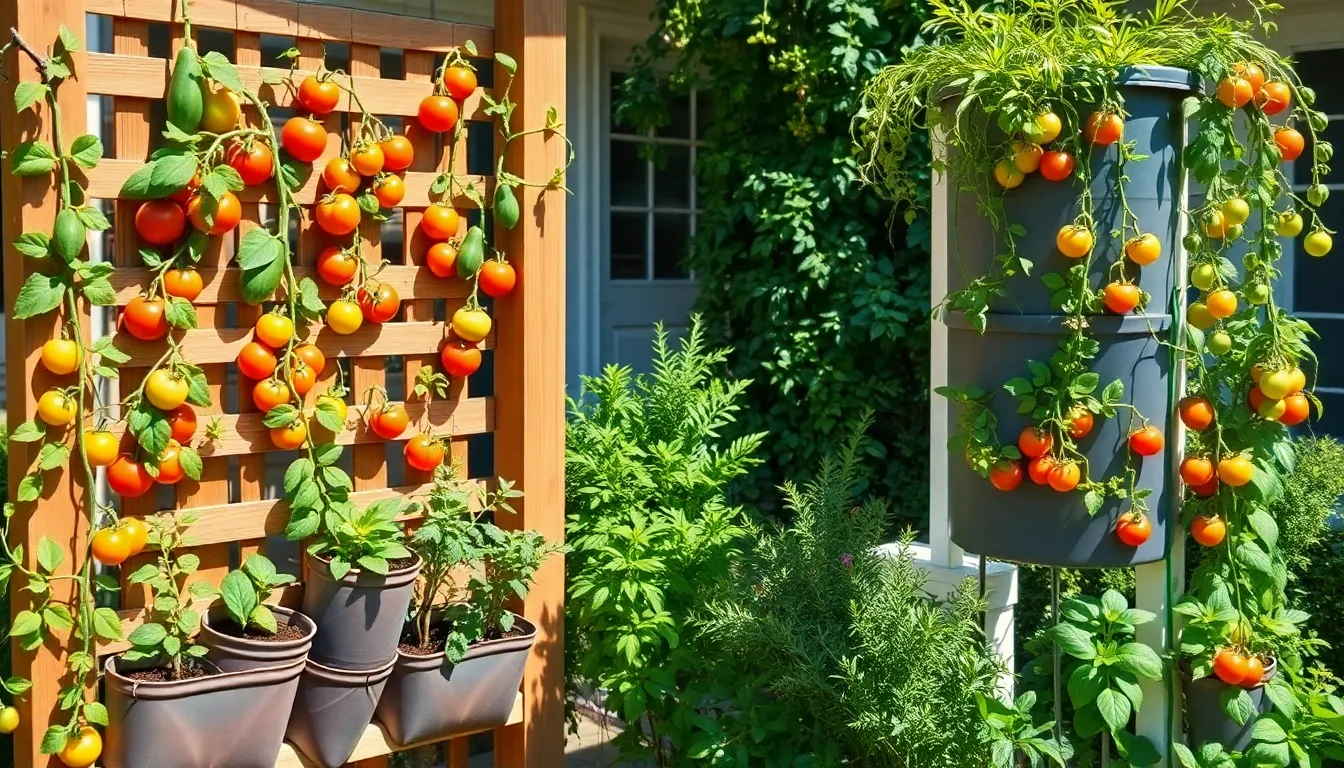
When space is limited in our front yards, we can dramatically increase our growing capacity by building upward rather than outward. Vertical gardening systems allow us to produce more vegetables in smaller footprints while creating stunning visual displays.
Install Trellises and Arbors for Climbing Vegetables
Trellises transform our gardens into productive vertical spaces by supporting climbing vegetables like tomatoes, beans, peas, and squash. We can construct these structures using wood, metal, or PVC materials depending on our budget and aesthetic preferences.
Wood trellises offer natural beauty and blend seamlessly with traditional home styles. Cedar and redwood provide excellent durability against weather conditions while requiring minimal maintenance.
Metal trellises create sleek, modern appearances that complement contemporary architecture. Galvanized steel or powder-coated aluminum options resist rust and support heavier vegetable varieties like indeterminate tomatoes.
PVC trellises deliver cost-effective answers for budget-conscious gardeners. These lightweight structures are easy to install and relocate as our garden needs change throughout seasons.
Arbors serve dual purposes by creating attractive entryways while supporting vigorous climbing plants like cucumbers and pole beans. We can position these structures at garden entrances or along pathways to maximize both function and visual appeal.
Build Living Walls with Pocket Planters
Living walls revolutionize how we approach dense planting in compact front yard spaces. These vertical structures accommodate many herbs and small vegetables using wooden or plastic pocket planters arranged in tiered formations.
Wooden pocket planters integrate naturally with industry designs while providing excellent drainage for root vegetables and leafy greens. Cedar construction resists moisture damage and maintains structural integrity across multiple growing seasons.
Plastic planters offer lightweight alternatives that are easy to mount and rearrange. UV-resistant materials prevent cracking and fading while accommodating frequent watering schedules required by vertical gardens.
Pocket arrangements maximize growing density by allowing us to plant herbs like basil, oregano, and thyme alongside compact vegetables such as lettuce and spinach. Each pocket creates its own microenvironment for optimal plant growth.
Installation flexibility enables us to mount living walls on existing fences, garage walls, or standalone frames. Strategic positioning ensures adequate sunlight exposure while protecting plants from strong winds.
Use Container Towers for Herbs and Compact Vegetables
Container towers provide space-efficient growing answers perfectly suited for small front yards and urban gardening situations. We can stack plastic or terracotta containers vertically to create productive growing columns.
Plastic containers offer lightweight portability and excellent moisture retention for herbs and compact vegetables. Stackable designs with built-in water reservoirs ensure consistent hydration throughout the tower system.
Terracotta containers provide superior breathability for root systems while adding rustic charm to garden designs. Natural clay materials regulate soil temperature and prevent waterlogging in stacked arrangements.
Tower construction involves creating drainage systems between stacked containers to prevent water accumulation. We can drill holes in container bottoms and add gravel layers for optimal water flow.
Plant selection focuses on compact varieties like cherry tomatoes, bush beans, and cascading herbs that thrive in confined spaces. Strawberry plants and trailing nasturtiums create beautiful spillover effects from upper containers.
Maintenance advantages include easy access to all plants without bending, simplified watering through top-down irrigation, and convenient harvesting at comfortable heights.
Establish Edible Landscaping with Ornamental Food Plants
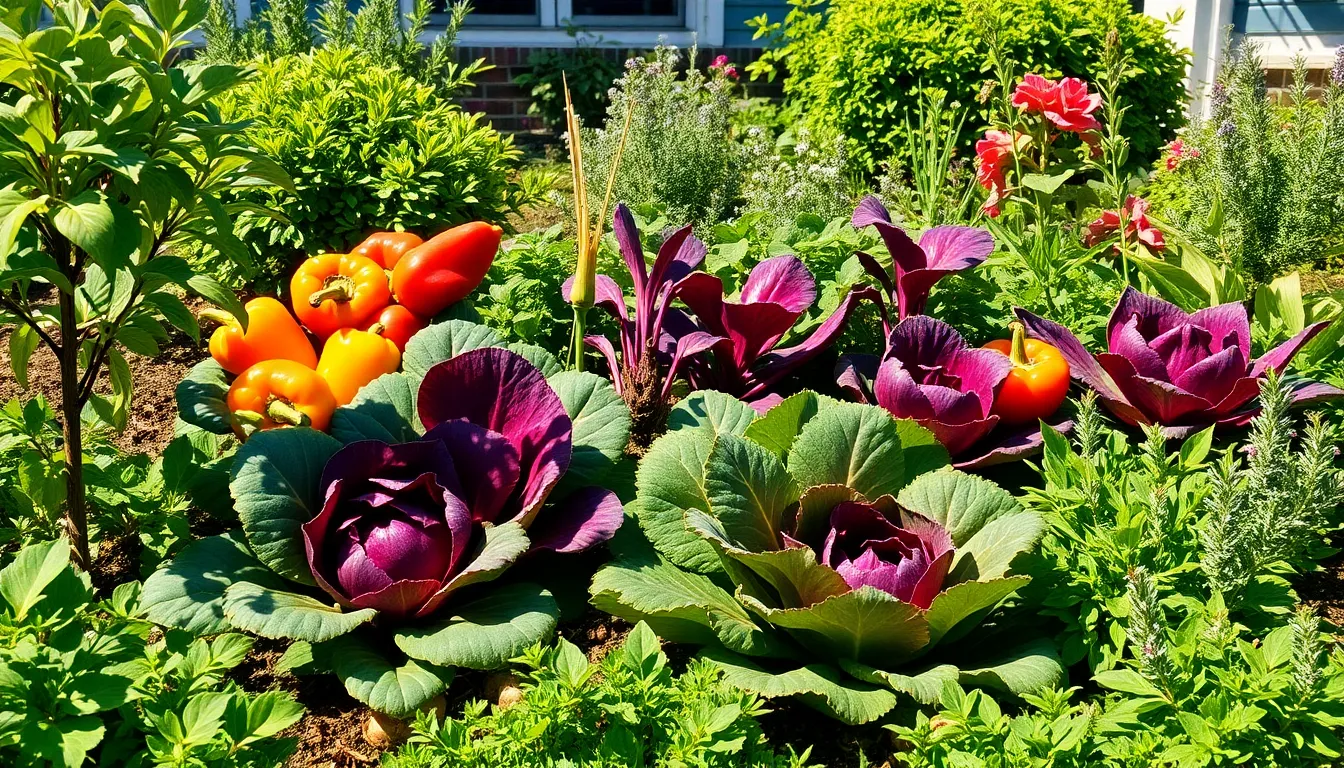
Edible landscaping transforms traditional ornamental gardens into productive spaces that feed our families while maintaining stunning curb appeal. We can create visually striking borders using food plants that offer both beauty and functionality.
Choose Colorful Vegetables That Double as Decorative Elements
Colorful vegetables serve as natural artwork in our front yard gardens, providing vibrant hues that rival traditional flowers. Multi-colored bell peppers create stunning focal points with their bright reds, yellows, and purples, while rainbow chard displays spectacular stems in brilliant pink, orange, and yellow tones. Red lettuce varieties like ‘Red Sails’ and ‘Lollo Rosso’ form beautiful burgundy rosettes that complement any garden design.
Purple vegetables add dramatic contrast to green foliage, with purple beets offering deep violet leaves and bright magenta stems. Orange carrots with their feathery green tops create textural interest, especially when we plant varieties like ‘Purple Haze’ and ‘Rainbow’ carrots for maximum color impact. Red cabbage forms perfect purple globes that look stunning planted in geometric patterns or mixed borders.
We can arrange these colorful vegetables in alternating patterns to create living tapestries that change throughout the growing season. Leafy greens like kale varieties ‘Redbor’ and ‘Winterbor’ provide architectural structure with their curled, colorful leaves that persist through cooler months.
Integrate Fruit Trees as Natural Focal Points
Fruit trees create magnificent focal points while providing fresh produce for our households. Dwarf apple trees reach manageable heights of 6-8 feet, making them perfect for front yard landscapes without overwhelming the space. Citrus trees like dwarf Meyer lemons or key limes add glossy evergreen foliage and fragrant blossoms that enhance our garden’s sensory appeal.
Dwarf fruit trees require minimal space while delivering maximum visual impact through their seasonal changes. Spring brings delicate blossoms, summer offers lush foliage, and fall displays colorful fruit that attracts beneficial wildlife. We can position these trees at garden corners or use them to frame entryways for dramatic effect.
Cherry trees provide spectacular spring flowering displays, while dwarf peach and pear varieties offer manageable sizes perfect for suburban front yards. Espalier training techniques allow us to grow fruit trees against fences or walls, creating living art installations that save space while producing abundant harvests.
Plant Herb Borders for Fragrance and Functionality
Herb borders deliver aromatic experiences while providing fresh ingredients for our kitchens. Rosemary creates sturdy evergreen hedges that release pine-like fragrance when brushed against, making perfect pathway edging. Thyme varieties form low-growing carpets that release pleasant scents underfoot and attract beneficial pollinators with their tiny flowers.
Oregano spreads naturally to create fragrant ground cover, while basil varieties offer diverse colors and textures from purple ‘Dark Opal’ to compact ‘Spicy Globe’ types. We can design herb borders using varying heights, placing tall rosemary and sage plants as backdrop elements, medium height oregano and thyme in middle sections, and low growing chives as front edging.
Mediterranean herbs like lavender and sage provide drought tolerance while offering natural pest deterrent properties. These aromatic plants help protect nearby vegetables from harmful insects while creating pleasant scented barriers along walkways and garden edges. Herb borders require minimal maintenance once established, making them perfect for busy gardeners who want maximum impact with minimal effort.
Incorporate Water-Efficient Irrigation Solutions
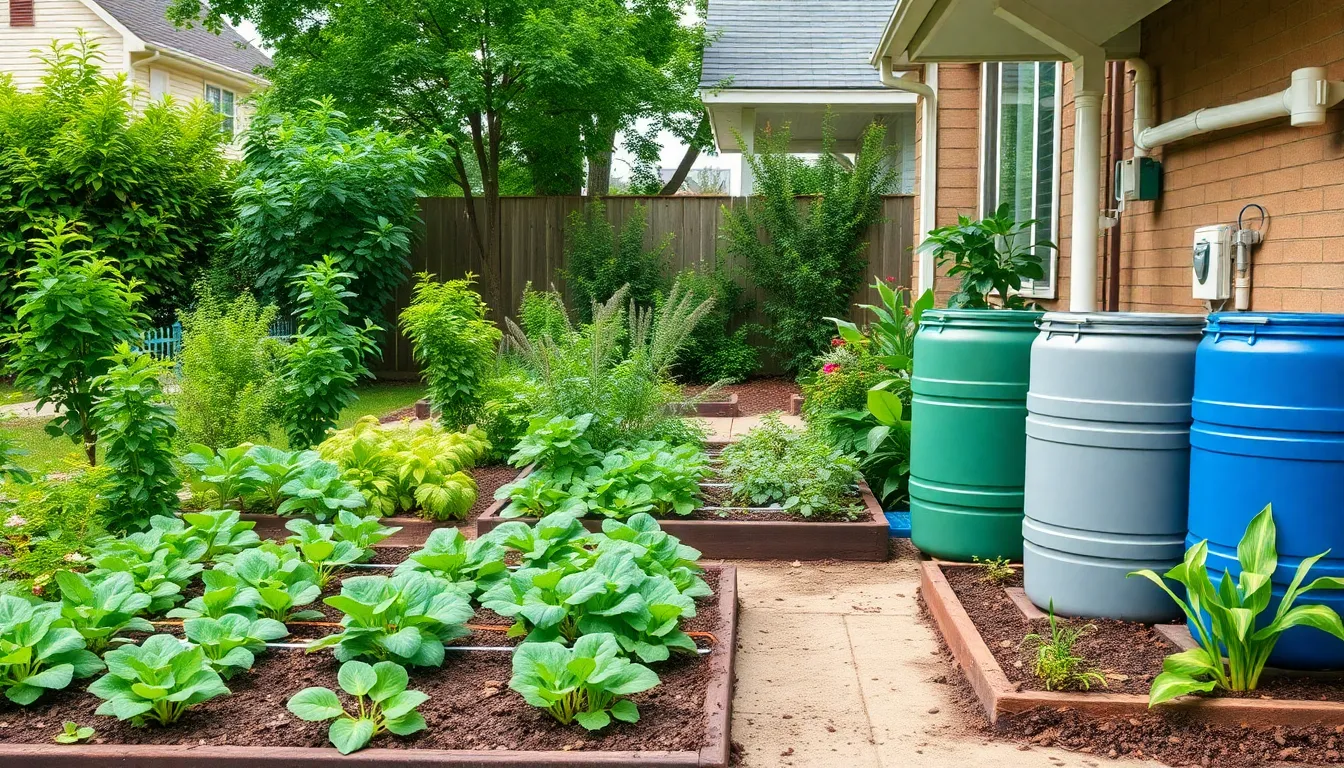
Water conservation becomes essential when transforming your front yard into a productive vegetable garden. Smart irrigation systems can reduce water usage by up to 50% while maintaining healthy plant growth throughout the growing season.
Install Drip Irrigation Systems for Consistent Watering
Drip irrigation systems deliver water directly to plant roots, eliminating waste from evaporation and runoff. These systems work exceptionally well with raised beds, providing the well-drained soil conditions that vegetables need to thrive. We can install timers to automate watering schedules, ensuring consistent moisture levels even during busy periods.
Installation involves laying perforated tubing along plant rows and connecting it to a main water source. Pressure regulators maintain optimal water flow, while emitters can be adjusted for different plant requirements. Tomatoes and peppers benefit from steady moisture delivery, while leafy greens require more frequent but lighter watering sessions.
The system pays for itself through reduced water bills and healthier plant yields. Maintenance requires only periodic cleaning of emitters and seasonal winterization in colder climates.
Set Up Rain Collection Barrels for Sustainable Gardening
Rain collection barrels capture and store natural precipitation for non-potable garden uses. These sustainable answers reduce dependence on municipal water supplies while providing free irrigation water during dry spells. We can connect multiple barrels to increase storage capacity for larger front yard gardens.
Positioning barrels under downspouts maximizes water collection from roof runoff. First flush diverters improve water quality by redirecting initial rainfall that washes debris from rooftops. Spigots installed near the bottom allow easy access for filling watering cans or connecting to drip irrigation systems.
Screen covers prevent mosquito breeding while allowing water entry. Overflow valves direct excess water away from home foundations during heavy rainfall events. Most residential systems can collect 600 gallons of water from just one inch of rainfall on a 1,000 square foot roof.
Choose Drought-Tolerant Vegetables for Low-Maintenance Care
Drought-tolerant vegetables require minimal water once established, making them perfect for sustainable front yard gardens. Tomatoes, peppers, and okra thrive in well-drained soil with infrequent but deep watering sessions. These heat-loving crops actually develop stronger root systems and more concentrated flavors when grown with less water.
Mediterranean herbs like rosemary, thyme, and oregano naturally resist drought conditions while providing fresh seasonings for cooking. Succulents such as purslane offer edible leaves and stems with virtually no water requirements beyond natural rainfall.
We can group drought-resistant varieties together to create low-maintenance garden zones. These areas require watering only during extended dry periods, reducing overall garden maintenance time. Root vegetables like carrots and beets also perform well with minimal irrigation once their taproot systems develop.
Plant selection should consider your local climate zone and average rainfall patterns. Native vegetables adapted to regional conditions typically require the least supplemental watering while producing reliable harvests.
Plan Seasonal Succession Planting for Year-Round Harvests
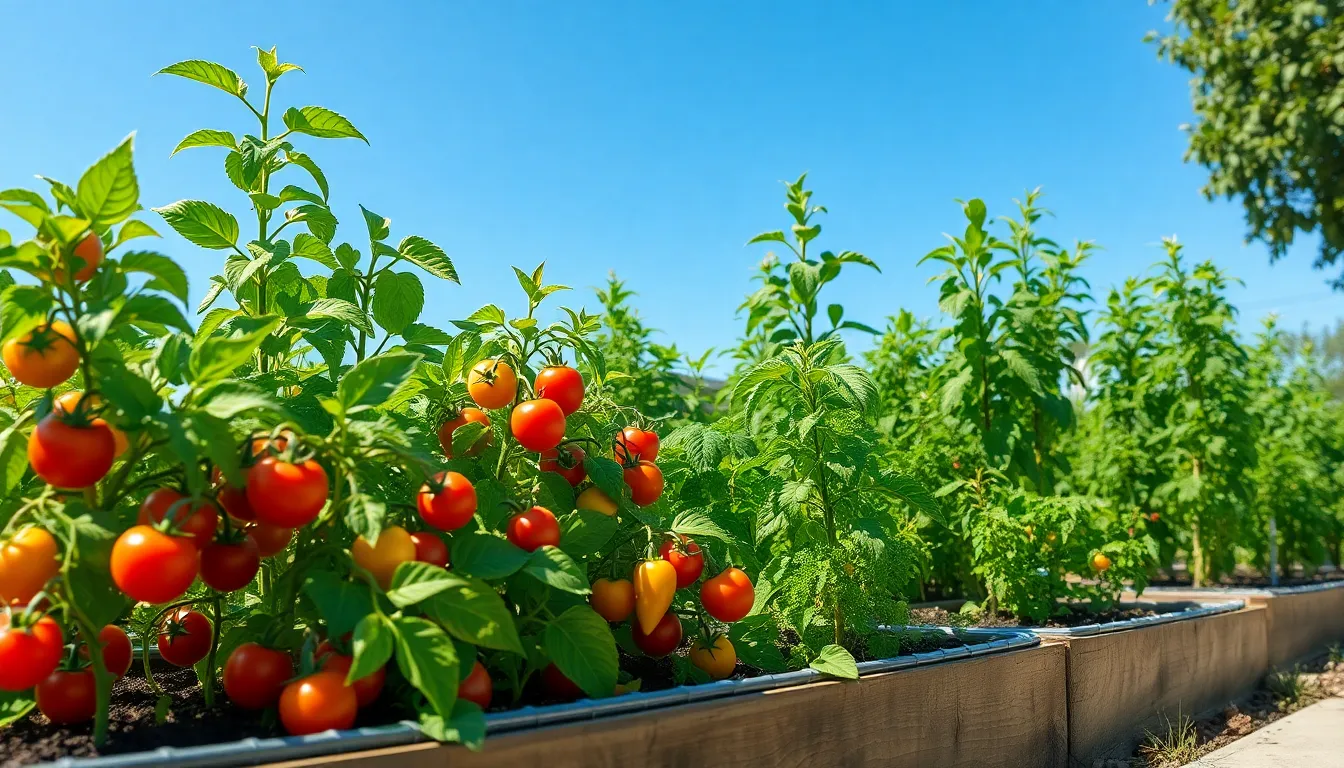
Strategic timing transforms front yard vegetable gardens into continuous food production systems. We can maximize our harvest potential by carefully scheduling plantings throughout the seasons to ensure fresh vegetables reach our tables twelve months annually.
Schedule Cool-Season Crops for Spring and Fall
Cool-season vegetables thrive when temperatures range between 45-65°F, making spring and fall our ideal planting windows. We should plant broccoli, kale, and carrots during early spring when soil temperatures reach 40°F consistently. March plantings typically yield robust harvests by late May, while our second succession begins in late August for fall production.
Timing becomes crucial for maximizing these dual growing seasons in our front yard gardens. We can extend harvests by staggering plantings every 2-3 weeks during peak seasons, ensuring continuous vegetable availability. Cool weather crops like spinach and lettuce actually improve in flavor after light frost exposure, making them perfect candidates for extending our growing season well into November.
Planning succession cycles allows us to use the same garden space multiple times per year. We should prepare our soil with fresh compost between plantings to maintain nutrient levels for consecutive crops.
Select Heat-Tolerant Varieties for Summer Production
Heat-tolerant vegetables become essential during summer months when temperatures soar above 80°F consistently. We must choose varieties like tomatoes, peppers, and okra that actually thrive in intense heat conditions. These plants typically require full sun exposure and can withstand temperature spikes that would stress cool-season crops.
Summer production requires different watering strategies to support heat-loving vegetables through extreme conditions. We should carry out drip irrigation systems to deliver consistent moisture directly to root zones without waste. Mulching around plants helps retain soil moisture and regulate temperature fluctuations.
Selecting appropriate cultivars ensures successful summer harvests in challenging weather conditions. We can choose determinate tomato varieties that produce concentrated harvests before peak summer heat, while indeterminate types provide steady production throughout the season.
Prepare Winter Growing Areas in Mild Climates
Winter growing becomes possible in USDA zones 8-10 where temperatures rarely drop below 20°F. We should designate exact garden areas for cold-hardy vegetables like spinach, lettuce, and Brussels sprouts that continue producing through mild winter months. Protected microclimates near south-facing walls or structures provide additional warmth for sensitive plants.
Row covers and cold frames extend our growing capabilities even further in borderline climates. We can construct simple protection systems using clear plastic or glass to trap solar heat during short winter days. These structures raise temperatures by 5-10°F, often making the difference between plant survival and frost damage.
Soil preparation becomes critical for winter success since root development slows significantly in cold conditions. We should incorporate extra organic matter and ensure excellent drainage to prevent waterlogged conditions that harm overwintering plants.
Address Common Front Yard Gardening Challenges
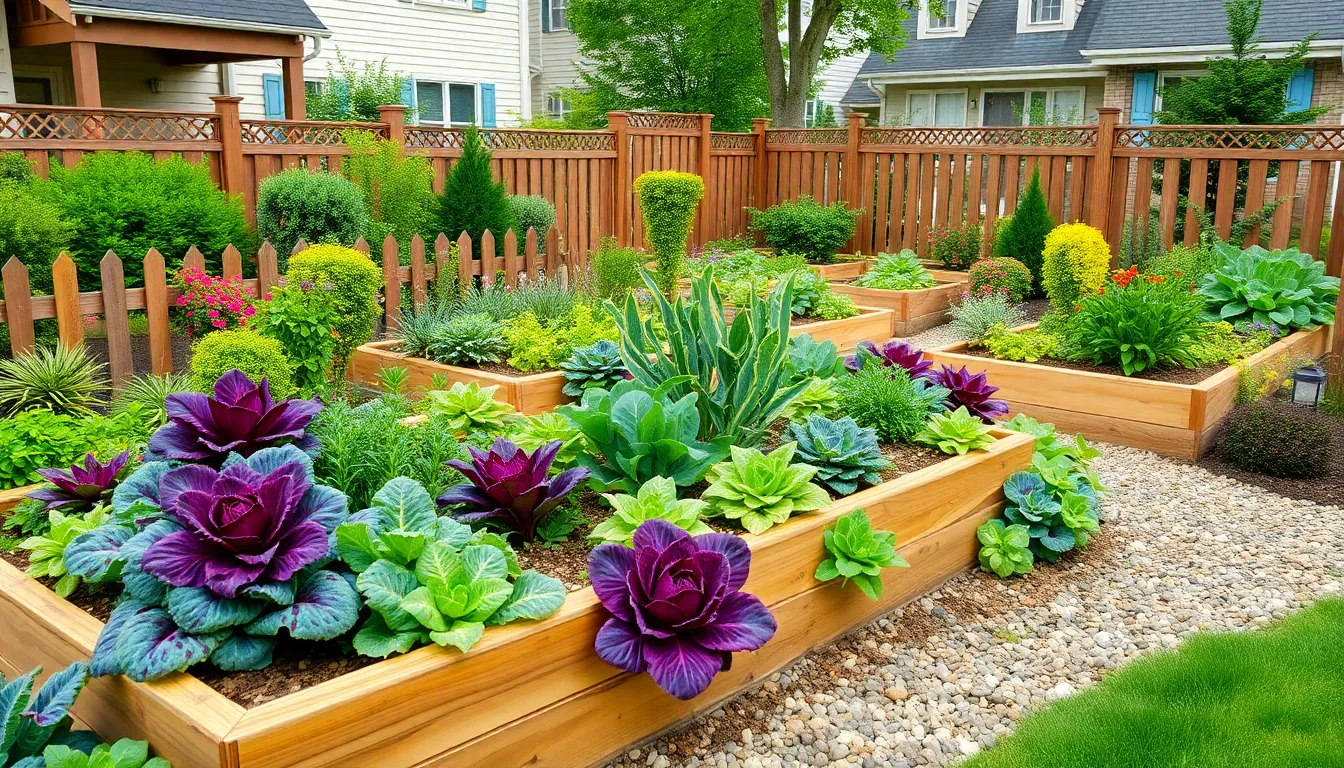
Successfully establishing a front yard vegetable garden requires addressing several practical concerns that don’t typically affect backyard growing spaces.
Navigate HOA Restrictions and Neighborhood Guidelines
Research your homeowner’s association rules and local ordinances before breaking ground on your front yard garden project. Many HOAs have exact guidelines about front yard modifications, plant height restrictions, and overall aesthetic standards that must be followed.
Contact your HOA board directly to discuss your vegetable garden plans and request written approval for your proposed design. Document all communications and keep copies of approved plans to protect yourself from future disputes.
Consider incorporating ornamental elements like decorative borders, attractive plant supports, and neat pathways to ensure your garden meets community aesthetic standards. Choose vegetables with appealing foliage colors and textures, such as purple kale or variegated lettuce, to create visual interest that satisfies neighborhood expectations.
Schedule regular maintenance to keep your garden looking pristine and well organized throughout the growing season. Weeds, overgrown plants, and cluttered growing areas can quickly draw complaints from neighbors or HOA officials.
Protect Plants from Foot Traffic and Curious Neighbors
Install low decorative fencing around garden beds to create clear boundaries while maintaining an open, welcoming appearance. Materials like bamboo screening, picket fencing, or wrought iron borders provide protection without creating fortress like barriers.
Position raised beds at least 18 inches from sidewalks and pathways to prevent accidental damage from pedestrians and delivery personnel. Elevated growing spaces also make it easier for neighbors to see and appreciate your garden without feeling tempted to touch or sample plants.
Create clear walking paths through your garden using gravel, stepping stones, or mulched trails to direct foot traffic away from growing areas. Strategic pathway placement helps visitors navigate your space without trampling delicate seedlings or mature plants.
Post friendly educational signs near your garden entrance to inform neighbors about your growing project and encourage respectful viewing. Simple messages like “Please enjoy our garden with your eyes” or “Fresh vegetables growing here” help establish boundaries while maintaining community goodwill.
Manage Pest Control in High-Visibility Areas
Apply organic pest control methods that won’t concern neighbors or create unsightly garden conditions. Neem oil, diatomaceous earth, and beneficial insect releases provide effective pest management without harsh chemical odors or visible residues.
Carry out companion planting strategies using aromatic herbs like basil, marigolds, and nasturtiums to naturally repel common garden pests. These pest deterrent plants add color and fragrance while reducing the need for visible pest control interventions.
Monitor your garden daily for early pest detection and address problems immediately before they become noticeable to passing neighbors. Quick action prevents minor pest issues from developing into major infestations that could draw community complaints.
Choose naturally pest resistant vegetable varieties whenever possible to minimize the need for ongoing pest management in your highly visible front yard space. Disease resistant tomatoes, pest tolerant leafy greens, and hardy root vegetables require fewer interventions and maintain better appearance throughout the growing season.
Maintain Your Front Yard Vegetable Garden for Long-Term Success
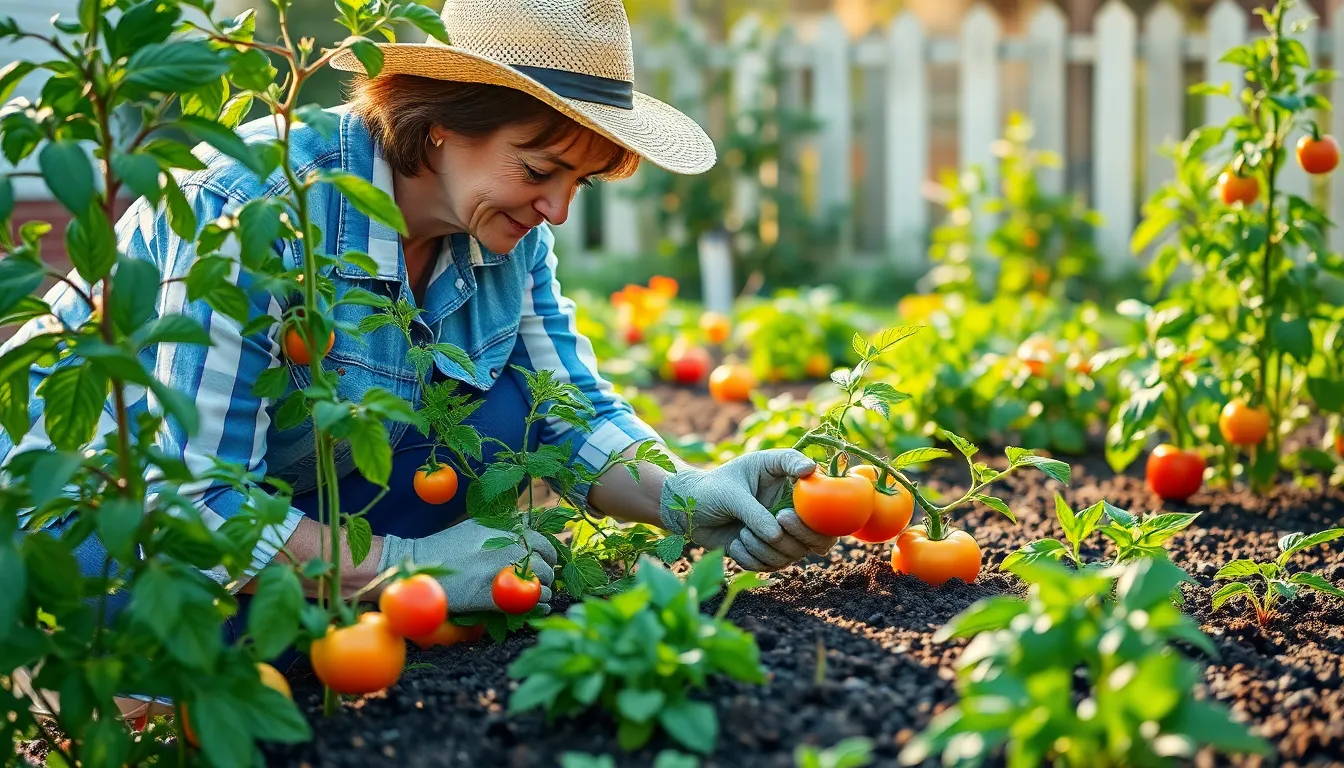
Successful front yard vegetable gardens require consistent care and strategic planning to thrive year after year. We’ll establish proven maintenance practices that keep our gardens productive while maintaining the curb appeal that makes them neighborhood standouts.
Develop a Regular Maintenance Schedule
Weekly maintenance routines form the foundation of successful front yard vegetable gardening. We recommend dedicating 2-3 hours each week to essential tasks like watering, pruning, and pest inspection to prevent small issues from becoming major problems.
Morning sessions work best for maintenance activities since we can assess plant health before the day’s heat stresses our vegetables. Checking soil moisture levels helps us determine watering needs, while examining leaves for signs of disease or pest damage allows for early intervention.
Pruning tasks vary by season but consistently promote healthier plant growth and better yields. We remove dead or diseased foliage weekly, trim suckers from tomato plants, and harvest mature vegetables to encourage continued production.
Regular weeding prevents competition for nutrients and maintains the polished appearance essential for front yard gardens. Spending 15-20 minutes daily on spot weeding eliminates the need for marathon weekend sessions and keeps our gardens looking professional.
Practice Crop Rotation to Preserve Soil Health
Crop rotation prevents soil depletion and reduces pest buildup by moving plant families to different garden sections each season. We divide our vegetables into four main groups: nightshades (tomatoes, peppers), brassicas (cabbage, broccoli), legumes (beans, peas), and root vegetables (carrots, radishes).
Annual rotation schedules help us maintain soil fertility by alternating heavy feeders with soil builders. Legumes naturally fix nitrogen in the soil, making them ideal predecessors for nitrogen hungry crops like leafy greens and brassicas.
Four year rotation cycles provide optimal results for most front yard gardens, allowing sufficient time for soil recovery between similar crop families. We map our garden beds and track which plant families occupy each section to ensure proper rotation timing.
Companion planting enhances rotation benefits by combining plants that support each other’s growth. Planting nitrogen fixing beans alongside corn creates natural fertilization, while aromatic herbs like basil can deter pests when planted near tomatoes.
Keep Detailed Records for Future Planning
Garden journals document our successes and challenges, creating valuable references for improving future seasons. We track planting dates, varieties selected, weather conditions, and harvest yields to identify patterns and optimize our gardening strategies.
Digital apps and spreadsheets streamline record keeping by allowing us to easily sort and analyze garden data. Photos taken throughout the growing season provide visual records of plant development, pest issues, and design elements that worked well.
Yield tracking helps us calculate return on investment and plan appropriate quantities for future plantings. Recording pounds harvested per square foot reveals which varieties perform best in our exact front yard conditions.
Weather data correlation with plant performance guides our variety selection and timing decisions. Noting temperature extremes, rainfall amounts, and seasonal patterns helps us choose resilient varieties and adjust planting schedules for optimal results.
Maintenance schedules documented in our records reveal which tasks require more or less attention in different seasons. This information helps us allocate time efficiently and anticipate peak maintenance periods throughout the year.
Conclusion
We’ve shown you that transforming your front yard into a productive vegetable garden isn’t just a dream—it’s an achievable reality that combines beauty with function. Whether you choose raised beds container towers or vertical growing systems you’re creating a space that feeds your family while boosting your home’s value.
The key to success lies in smart planning and consistent care. By selecting the right plants for your climate implementing water-saving techniques and maintaining regular schedules you’ll enjoy fresh harvests year-round.
Your front yard vegetable garden will become more than just a growing space—it’ll be a conversation starter that inspires neighbors and proves that sustainable living can be both practical and beautiful. Start small dream big and watch your edible industry flourish.
Frequently Asked Questions
Can I convert my front lawn into a vegetable garden without extensive gardening experience?
Yes, you can successfully transform your front yard into a productive vegetable garden even as a beginner. The key is strategic planning and smart design choices. Start with easy-to-grow vegetables, choose the right location for maximum sun exposure, and consider raised beds for easier maintenance. With proper soil preparation and a well-thought-out layout, even small spaces can yield fresh produce year-round.
How do I choose the best location in my front yard for vegetables?
Assess your yard’s sunlight patterns throughout the day to determine optimal placement. Most vegetables need 6-8 hours of direct sunlight, so position heat-loving crops like tomatoes and peppers in full sun areas. Shade-tolerant vegetables like lettuce and spinach can thrive in partially shaded spots. Also consider proximity to water sources and easy access for maintenance.
What are the benefits of using raised beds for front yard gardens?
Raised beds offer superior drainage, easier soil management, and enhanced curb appeal. They create structured growing spaces that serve as attractive focal points while providing practical benefits like improved soil quality and reduced weeding. Raised beds also make gardening more accessible and allow you to create geometric patterns that add visual interest to your landscape.
How can I make my vegetable garden look attractive from the street?
Incorporate ornamental food plants like colorful bell peppers and rainbow chard as decorative elements. Design geometric patterns with raised beds, add pathways using gravel or stone, and select materials that complement your home’s architecture. Consider dwarf fruit trees as natural focal points and plant herb borders for added fragrance and visual appeal.
What vegetables are best for beginners in front yard gardens?
Start with easy-to-grow, visually appealing vegetables like lettuce, herbs, cherry tomatoes, and peppers. These crops are forgiving for beginners and add color to your landscape. Cool-season crops like broccoli and kale work well for spring and fall planting, while heat-tolerant varieties like tomatoes thrive in summer months.
How do I deal with HOA restrictions when planning a front yard garden?
Research local ordinances and HOA guidelines before starting your project. Many communities allow vegetable gardens if they’re well-maintained and aesthetically pleasing. Incorporate ornamental elements, use decorative fencing, and ensure regular maintenance. Consider submitting detailed plans showing how your garden will enhance curb appeal rather than detract from neighborhood aesthetics.
What’s the best way to water my front yard vegetable garden efficiently?
Install drip irrigation systems that deliver water directly to plant roots, reducing waste and ensuring consistent moisture. Set up rain collection barrels to capture natural precipitation for sustainable irrigation. Group plants with similar watering needs together and choose drought-tolerant varieties like Mediterranean herbs to minimize water requirements.
How can I maximize space in a small front yard garden?
Utilize vertical gardening systems with trellises and arbors for climbing vegetables. Install living walls with pocket planters for herbs and small vegetables, and use container towers that stack pots vertically. These innovative approaches enhance productivity while maintaining visual appeal, making them perfect for compact urban spaces.
When should I plant different vegetables throughout the year?
Practice seasonal succession planting for continuous harvests. Plant cool-season crops like broccoli and kale in spring and fall. Summer is ideal for heat-tolerant varieties like tomatoes and peppers. In milder climates, grow cold-hardy vegetables in winter using protective structures like row covers to extend growing seasons.
How much time does maintaining a front yard vegetable garden require?
Dedicate 2-3 hours weekly to essential tasks like watering, pruning, and pest inspection. Morning sessions work best for assessing plant health before heat stress occurs. Establish a regular maintenance schedule and keep detailed records of planting dates, weather conditions, and harvest yields to improve future gardening strategies and maximize productivity.

